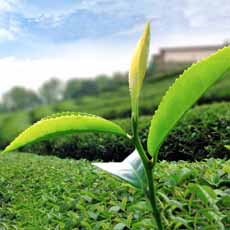Celebrate The First National Tea Day With These Tea Facts
|
|
January 12th is the first-ever National Hot Tea Day, declared by the Tea Council of the USA, a trade association. Tea is the second most-consumed beverage in the world, after water. So have a cup as you read this: Black, green, or white, all tea comes from the Camellia sinensis plant (photos #1 and #2), a warm-weather evergreen. There’s one slight exception and one larger one: During oxidation, the tea leaves undergo natural chemical reactions that result in distinctive color and taste characteristics. Along with wine grapes, coffee, cacao beans, and other agricultural products, local soil and climate result in corresponding flavor, aroma, and color variations (photo #3). As with coffee, each tea takes its name from the area in which it’s grown, and the areas in turn are known for their distinctive and uniquely flavored teas. Tea is also divided by grades, determined by leaf size. Smaller-sized leaves are used in tea bags while the larger-sized leaves can be found in packaged loose tea. While China is the world’s largest tea-producing nation, it keeps most of what it grows for its own consumption. The second largest consuming nation, India, is the largest exporter, followed by Sri Lanka, Kenya, Indonesia, Japan, and Taiwan. The largest importing nations are the United Kingdom, Australia, Canada, Russia, the United States, and The Netherlands. |
|
|
As with all foods, you can buy the average, the sublime, or something in-between. If you love a good cup of tea—or a tall frosty glass of iced tea—you’ll appreciate the difference between fine, “gourmet” tea made from top-quality whole leaves and mass-marketed tea bags produced from bits and pieces. A tip: When you buy higher-priced teas, first taste them plain, without milk or sweetener. The finest teas should be drunk black (plain) to appreciate their nuanced flavors and aromas. FINAL TIP: Don’t toss the leftover tea in the pot—pour it into ice cube trays. Tea ice cubes won’t dilute your iced tea. (Our favorite ice cube tray is the ISI Orka Ice Cube Tray—read our review to see why.) CHECK OUT WHAT’S HAPPENING ON OUR HOME PAGE, THENIBBLE.COM.
|
||





